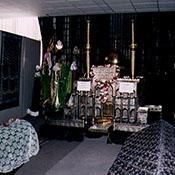 For the first ten days in the month of Muharram, Shi’i Muslims mourn the martyrdom of Husayn (the grandson of Prophet Muhammad) and the other marytrs of Karbala. In places like Dearborn, Michigan, Shi’i Muslims recite or enact the martyrdom story (taziya) to commemorate the sacrifice. Wearing black, some women also gather on the seventh day for the “marriage of Kaseem” mourning procession.
For the first ten days in the month of Muharram, Shi’i Muslims mourn the martyrdom of Husayn (the grandson of Prophet Muhammad) and the other marytrs of Karbala. In places like Dearborn, Michigan, Shi’i Muslims recite or enact the martyrdom story (taziya) to commemorate the sacrifice. Wearing black, some women also gather on the seventh day for the “marriage of Kaseem” mourning procession.
View Full Album
Muharram is the first month of the Muslim lunar calendar. For Shi’i Muslims, it begins with a time of mourning to commemorate the death of Husayn, grandson of the Prophet, and his infant son on the battlefield at Karbala in Iraq in the year 680 CE. This event has assumed great significance for the Shi’i community in times of persecution and oppression, as Husayn’s martyrdom provides an example of selfless sacrifice in the cause of God’s justice in the face of human oppression.
At Muhammad’s death, the majority of his followers elected Abu Bakr as the first caliph to lead the community. A dissenting group believed that the spiritual and temporal authority of the Prophet rightly belonged only to the descendants of the Prophet, through his daughter Fatima and his son-in-law Ali (b. Abi Talib). This group became known as Shi’at Ali, the “partisans of Ali,” a name later shortened to the Shi’ah. Ali later became the fourth caliph, but his sons were challenged by the Arab governors of Greater Syria who became the Umayyad caliphs. Hasan, Ali’s first son, conceded the caliphate to Mu’awiya, on the grounds that the Muslim community would elect the next caliph after him. However Mu’awiya reneged on this truce and self-appointed his son Yazid, as the next caliph. The supporters of Husayn, Ali’s second son, suggested he come to Iraq to establish a caliphate, but they failed to provide him with protection when the Umayyad caliph Yazid resisted. In a battle with the troops of Yazid in Karbala, Husayn’s party was cut off and massacred, including many direct descendants of the Prophet Muhammad’s family.
Shi’i Muslims commemorate this tragic martyrdom by mourning for the first ten days of the month of Muharram, a commemoration culminating in Ashura, the tenth day of that month. In Dearborn, Michigan, over one-third of the population is Arab American, many of them Shi’i Muslims, and most of them now in the second and third generation. More than a dozen mosques in the Detroit area, such as the Islamic Institute of Knowledge and the Islamic Center of America, are packed with worshippers on the first night of Muharram. Indeed, they may have several services a day during this ten-day period. Each day may include: an elegy, or mourning ceremony, for one of the martyrs at Karbala culminating in an elegy for Husayn on the ninth day; a retelling of the story of Karbala; recounting the virtues of Hasan, Husayn, and the Prophet’s family; special prayers; and distribution of meals and special dishes. Worshippers place small circular clay pieces on the ground before them as they pray; these clay discs are made of the soil of Karbala, the sacred place in Iraq where Husayn was martyred.
Distinctive to this period is the taziya, the recitation of the story of the death of Husayn and a ritualized lament for his martyrdom. The hundreds of people gathered in mosques in Dearborn wear black for these services. Adults, teenagers, and even infants may have black cloth strips tied about their heads, with the lament “Oh Husayn! Oh Karbala!” written on them. In some mosques, the taziya may be enacted as a “passion play” of the martyrdom. Whether the taziya is enacted or recited, the community participates with a refrain of lamentation, each person striking his or her chest with a fist as a symbolic gesture of mourning.
In some communities, on the seventh day of Muharram, women from the community gather in one of the mosques to observe what they call the “marriage of Kassem.” Kassem was the son of Husayn, martyred as a child at Karbala. At the head of the procession, which is both a wedding procession and a funeral procession, women wearing black clothing and black headbands bear trays of flowers and candles held high above their heads. At the microphone the dead Kassem’s mother calls to the betrothed bride of Kassem, “Come out, come out, oh Bride, and look around.” It is a haunting refrain. Women join the procession, lamenting, striking their hands against their chests, weeping for the dead who never had a chance to reach the prime of life.
The collective voice of the community during Muharram is one of mourning, but also of solidarity—wearing black, coming daily to the mosque and often staying late at night, participating day after day in the story of suffering. Sweets, pastries and other special dishes prepared for these days are brought to the mosque, shared, eaten as a blessing, and brought home to those who are unable to attend.